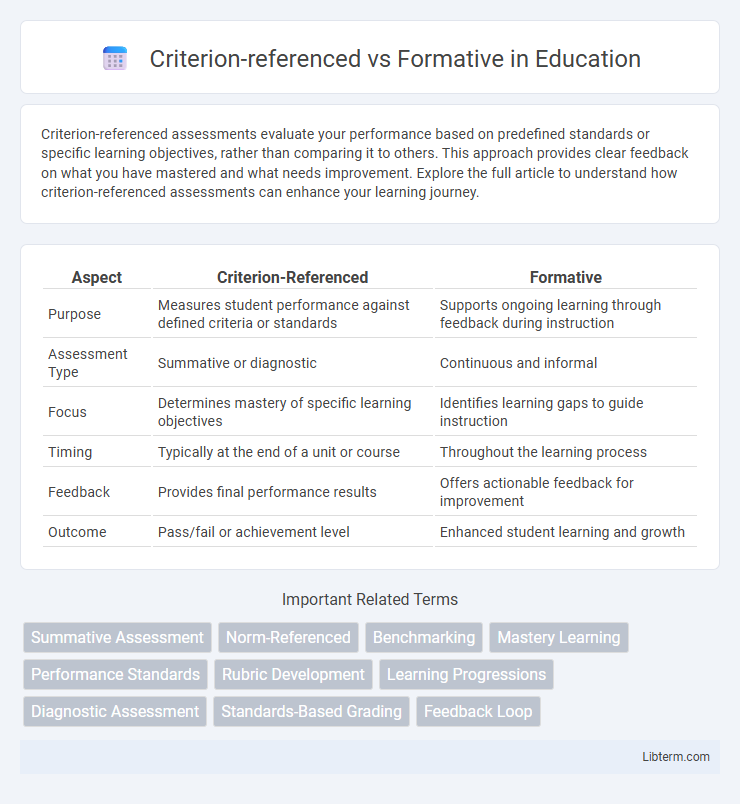Criterion-referenced assessments evaluate your performance based on predefined standards or specific learning objectives, rather than comparing it to others. This approach provides clear feedback on what you have mastered and what needs improvement. Explore the full article to understand how criterion-referenced assessments can enhance your learning journey.
Table of Comparison
| Aspect | Criterion-Referenced | Formative |
|---|---|---|
| Purpose | Measures student performance against defined criteria or standards | Supports ongoing learning through feedback during instruction |
| Assessment Type | Summative or diagnostic | Continuous and informal |
| Focus | Determines mastery of specific learning objectives | Identifies learning gaps to guide instruction |
| Timing | Typically at the end of a unit or course | Throughout the learning process |
| Feedback | Provides final performance results | Offers actionable feedback for improvement |
| Outcome | Pass/fail or achievement level | Enhanced student learning and growth |
Understanding Criterion-referenced Assessment
Criterion-referenced assessment measures student performance against a set of predefined learning standards or objectives, providing clear insights into individual mastery of specific skills or knowledge. This type of assessment enables educators to identify whether learners meet established criteria without comparing results to peers, facilitating targeted instructional strategies. Understanding criterion-referenced assessment is crucial for designing effective educational interventions that promote skill acquisition and competency development.
Defining Formative Assessment
Formative assessment is a continuous process used by educators to monitor student learning and provide ongoing feedback that can be used to improve instructional practices and student performance. Unlike criterion-referenced assessments that measure student achievement against a fixed standard or set of criteria, formative assessments focus on identifying learning gaps during the instructional process. This type of assessment includes quizzes, observations, and discussions designed to guide both teaching and student learning in real time.
Key Differences Between Criterion-referenced and Formative Assessments
Criterion-referenced assessments measure student performance against a fixed set of learning standards or criteria, providing clear benchmarks for mastery of specific skills. Formative assessments are ongoing evaluations used during the learning process to monitor progress and guide instructional adjustments, focusing on improvement rather than final outcomes. Criterion-referenced assessments yield summative results indicating whether learning objectives are met, whereas formative assessments emphasize feedback and adaptive learning to enhance student achievement.
Purpose and Goals: Criterion-referenced vs Formative
Criterion-referenced assessments aim to measure student performance against predefined standards or learning objectives, ensuring mastery of specific skills or knowledge. Formative assessments focus on monitoring student progress during the learning process to provide ongoing feedback and guide instructional adjustments. Both approaches serve to enhance educational outcomes but differ in timing and emphasis on mastery versus improvement.
Assessment Methods and Tools
Criterion-referenced assessment methods measure student performance against predefined learning standards or objectives using tools such as rubrics, checklists, and standardized tests. Formative assessment tools include quizzes, observations, and interactive activities designed to provide ongoing feedback and guide instructional adjustments. Both utilize data-driven techniques but differ in purpose, with criterion-referenced focusing on mastery evaluation and formative emphasizing learning progress.
Role in Student Learning and Development
Criterion-referenced assessments measure student performance against predefined learning standards, enabling targeted feedback that identifies specific strengths and weaknesses in mastering content. Formative assessments involve ongoing evaluations during instruction, providing continuous insights that inform teaching adjustments and support personalized student growth. Both assessment types play critical roles in fostering student learning by promoting self-awareness, guiding instructional improvement, and enhancing academic development.
Feedback Mechanisms in Both Assessments
Criterion-referenced assessments provide feedback by measuring student performance against predefined learning standards, offering clear indicators of mastery or areas needing improvement. Formative assessments deliver ongoing feedback designed to inform instructional adjustments and support student learning progress in real-time. Both assessments utilize feedback mechanisms to enhance learner outcomes, but formative assessments emphasize iterative guidance, while criterion-referenced assessments focus on meeting specific performance criteria.
Impact on Teaching Strategies
Criterion-referenced assessments provide clear benchmarks for teachers to design targeted instructional strategies that meet specific learning objectives. Formative assessments offer real-time feedback allowing educators to adjust teaching methods dynamically to address students' immediate needs. Both approaches significantly influence differentiated instruction and promote data-driven decision-making in classrooms.
Advantages and Limitations
Criterion-referenced assessments offer clear advantages by measuring student performance against predefined standards, making it straightforward to identify mastery of specific skills or knowledge. However, their limitation lies in potentially ignoring individual learning progress and failing to provide ongoing feedback for improvement. Formative assessments excel at guiding learning through continuous feedback and adaptation, but they can be time-consuming and may lack standardized benchmarks to compare student performance broadly.
Best Practices for Effective Implementation
Best practices for effective implementation of criterion-referenced assessments emphasize aligning evaluation criteria clearly with learning objectives, ensuring transparency for both educators and students. Formative assessments benefit from timely, specific feedback that guides learners toward mastery through iterative, personalized instruction. Integrating technology can enhance data tracking and adaptive learning, optimizing both criterion-referenced and formative strategies for improved educational outcomes.
Criterion-referenced Infographic

 libterm.com
libterm.com